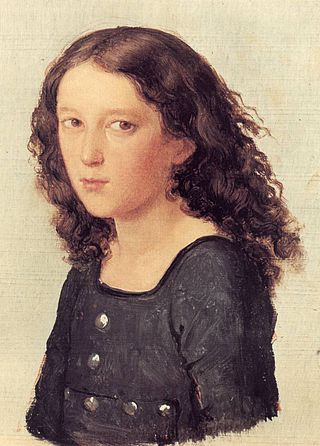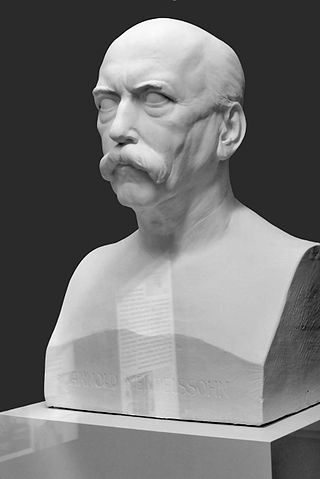This is a list of music-related events in 1820.

Felix Mendelssohn's Violin Concerto in E minor, Op. 64, MWV O 14, is his last concerto. Well received at its premiere, it has remained among the most prominent and highly-regarded violin concertos. It holds a central place in the violin repertoire and has developed a reputation as an essential concerto for all aspiring concert violinists to master, and usually one of the first Romantic era concertos they learn. A typical performance lasts just under half an hour.
A major is a major scale based on A, with the pitches A, B, C♯, D, E, F♯, and G♯. Its key signature has three sharps. Its relative minor is F-sharp minor and its parallel minor is A minor. The key of A major is the only key where the Neapolitan sixth chord on (i.e. the flattened supertonic) requires both a flat and a natural accidental.
F major is a major scale based on F, with the pitches F, G, A, B♭, C, D, and E. Its key signature has one flat. Its relative minor is D minor and its parallel minor is F minor.

The Concerto for Violin and String Orchestra in D minor, MWV O 3, was composed by Felix Mendelssohn at the age of thirteen. It has three movements, Allegro–Andante–Allegro, and performance duration is approximately 22 minutes.
The String Quartet No. 2 in A minor, Op. 13, was composed by Felix Mendelssohn in 1827. Written when he was 18 years old, it was, despite its official number, Mendelssohn's first mature string quartet. One of Mendelssohn's most passionate works, the A minor Quartet is one of the earliest and most significant examples of cyclic form in music.

Felix Mendelssohn composed his Viola Sonata in C minor, MWV Q 14, when he was only 14 years old. The autograph score is dated 14 February 1824. The work was not published in Mendelssohn's lifetime - in fact not until 1966 - and it was not assigned an opus number. Although he did reuse one of the themes from the minuet movement in the equivalent movement of his First Symphony.
The Violin Sonata in F minor, Op. 4, for violin and piano was composed by Felix Mendelssohn in 1823 and is the only one to carry an opus number. Mendelssohn composed two other violin sonatas, both in F major, that were not published in his lifetime. This was published with a dedication to his friend and violin teacher, Eduard Rietz, who was also dedicatee of the composer's Octet in E-flat major, Op. 20.

Arnold Ludwig Mendelssohn, was a German composer and music teacher.
Felix Mendelssohn's Sextet in D major, Op. 110, MWV Q 16, for piano, violin, two violas, cello, and double bass was composed in April–May 1824, when Mendelssohn was only 15, the same time he was working on a comic opera Die Hochzeit des Camacho. Its composition took place between the Viola Sonata and the Piano Quartet No. 3. It also preceded the famous Octet, Op. 20 by about a year. 1824 is also the probable year of the composition of the Clarinet Sonata. Like the latter, the Sextet was not published during the composer's lifetime. Its first edition was issued in 1868 as a part of a complete collection of Mendelssohn's works. Hence the misleading high opus number.
The Violin Sonata in F major, MWV Q 26, was composed in 1838 by Felix Mendelssohn, but remained unpublished during the composer's lifetime. It remained so until 1953 when violinist Yehudi Menuhin arranged it for publication
Felix Mendelssohn's Piano Quartet No. 1 in C minor, Op. 1, for piano, violin, viola and cello was completed on 18 October 1822 and dedicated to Polish Prince Antoni Radziwiłł. Mendelssohn's three numbered piano quartets were the first works of his to be published, hence their opus numbers.
Felix Mendelssohn began composing his Piano Quartet No. 3 in B minor, Op. 3, for piano, violin, viola and cello in late 1824 and completed it on 18 January 1825, just before his sixteenth birthday. The quartet was published later that year and was dedicated to Goethe whom Mendelssohn had met a few years earlier. Mendelssohn's three numbered piano quartets were the first works of his to be published, hence their opus numbers.

The Clarinet Sonata in E-flat major is a composition for clarinet and piano by Felix Mendelssohn.
The Piano Trio in C minor, MWV Q3, is a chamber work by Felix Mendelssohn. It was composed in 1820 and published posthumously in 1970. Unlike many other piano trios, this work is scored for piano, violin and viola. In key, all the movements are in minor, ending also in minor. Among the works by Mendelssohn, this is one of those least performed and recorded.

The Concerto for Piano, Violin, and Strings in D minor, MWV O4, also known as the Double Concerto in D minor, was written in 1823 by Felix Mendelssohn when he was 14 years old. This piece is Mendelssohn's fourth work for a solo instrument with orchestral accompaniment, preceded by a Largo and Allegro in D minor for Piano and Strings MWV O1, the Piano Concerto in A Minor MWV O2, and the Violin Concerto in D minor MWV O3. Mendelssohn composed the work to be performed for a private concert on May 25, 1823 at the Mendelssohn home in Berlin with his violin teacher and friend, Eduard Rietz. Following this private performance, Mendelssohn revised the scoring, adding winds and timpani and is possibly the first work in which Mendelssohn used winds and timpani in a large work. A public performance was given on July 3, 1823 at the Berlin Schauspielhaus. Like the A minor piano concerto (1822), it remained unpublished during Mendelssohn's lifetime and it wasn't until 1999 when a critical edition of the piece was available.
A concert piece is a musical composition, in most cases in one movement, intended for performance in a concert. Usually it is written for one or more virtuoso instrumental soloists and orchestral or piano accompaniment.
This article lists notable compositions within the viola repertoire. The list includes works in which the viola is a featured instrument. The list is ordered by composer surname.


